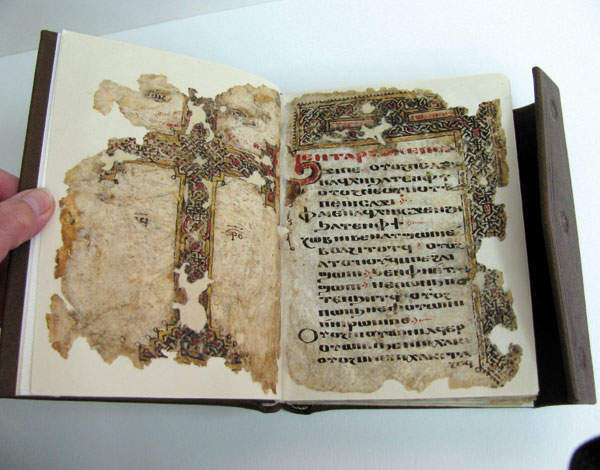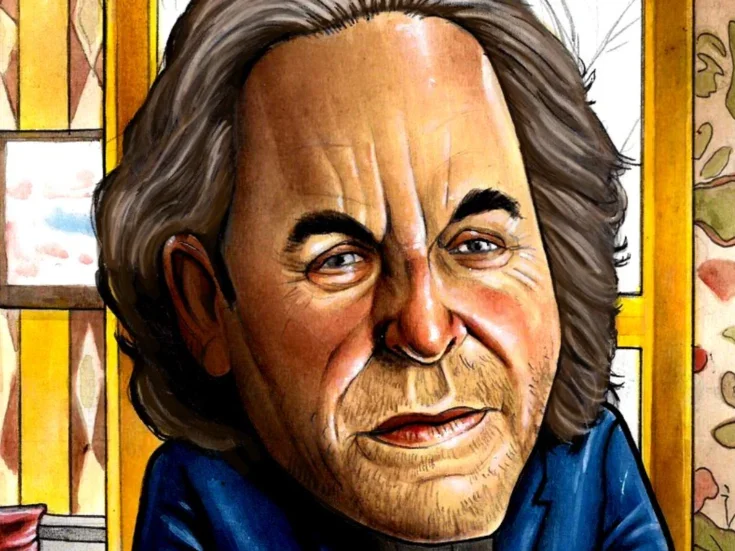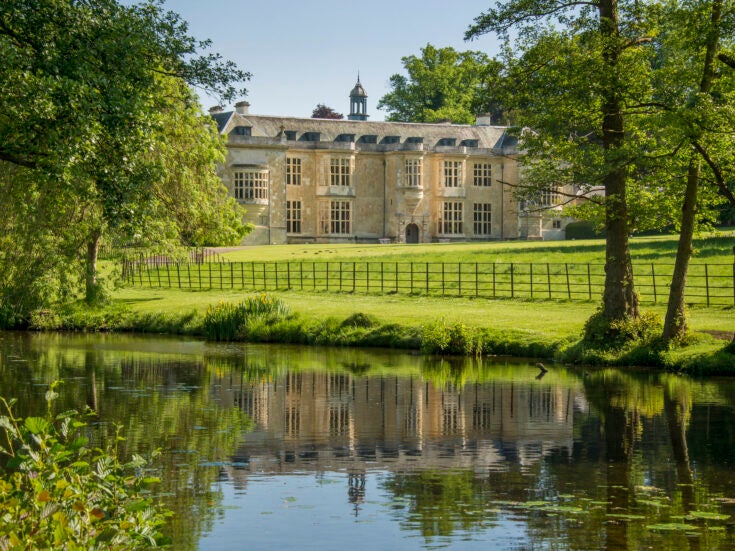

COPTIC ALLUSIONS
‘I have laid an anathema, by the word of God, on anyone who erases this note or effaces it, or who removes this book from the monastery for whatever reason. If anyone dares do so, let God’s anathema, wrath and curse be upon him.’
(Note of Abbot Mushe on a Syriac manuscript of Deir al-Surian, now in the Vatican)
One day in March 1837, the Honourable Robert (later Lord) Curzon, dressed in the long robes of a merchant of the East, mounted a camel in Cairo and, with Arab guides braving the djinns of the desert, headed off into the Sahara in search of manuscripts. He was not the first European to have heard of the fabled library of Deir al-Surian.
In the early 18th century, Pope Clement XI had sent his own emissaries to the Western Desert to acquire manuscripts for the Vatican. Other bibliophiles followed, to the enrichment of libraries from London to St Petersburg. The monks, taking fright at their dwindling stocks, battened down the hatches: from the mid-19th century to the dawn of the 21st the world was led to believe there was nothing left to take.
Read more on travel from Spear’s
But — in the sequel to a story that pitches Indiana Jones’ acquisitiveness against Umberto Eco’s hermeticism, with prerequisite curses and imprecations that everyone ignored — the arrival of a London-based paper conservator in 1996 would change all that. Her visit would eventually lead to the creation of a new monastic library building for some 2,500 bound texts and fragments, along with the revelation that Deir al-Surian remains the repository of some of the most ancient and significant texts in the world.
Deir al-Surian, ‘Monastery of the Syrians’, is a Coptic Orthodox monastery dedicated to the Holy Virgin in Wadi el-Natrun, the biblical Desert of Scetis. Known as a cradle of Christian monasticism, from the early years of the first millennium the region attracted anchorites, following the example of the apostle St Mark.
By the end of the 3rd century, monastic communities began to develop, eventually flourishing into 600 monasteries in the Western Desert. Deir al-Surian, founded in the 6th century, is one of only four to have survived, its Coptic community welcoming into the fold both Ethiopian and (until the 17th century) Syrian monks, after whom the monastery became known.
Capital outflow
The sprawling suburbs of Cairo have encroached upon much of the surrounding wilderness. But follow the Desert Highway for a 90-minute drive north-west from the capital and you will reach a timeless oasis that lies behind Deir al-Surian’s 40-foot blush-coloured walls.
Above these 10th-century defences peep the domes of churches, whose treasures — including magnificent frescoes dating from the 7th century — most visitors have come to see. Also visible are palm fronds, spires and, in the north-west corner, a squat tower complete with drawbridge, which is where this story begins.

The tower, built around AD 850, contained the monastery’s original library. It might have remained a library like any other, had it not been for a decision by the new vizier to tax the monasteries in Egypt. To plead exemption for Deir al-Surian, Abbot Mushe of Nisibis made his way to the Abbasid capital of Baghdad in 927, and, while awaiting the Caliph’s decision (it was favourable), embarked on a five-year spree that would yield a cache of 250 manuscripts from Syria and Mesopotamia.
This would form the core of his monastery’s collection which, over the years, increased to number Syriac, Coptic, Ethiopic and Christian-Arab texts, dating from the 5th to the 18th centuries. They would include biblical, Patristic and liturgical writings, as well as early translations of philosophy, medicine and science, many of whose original Greek texts have been lost.
Of these treasures, the most ancient are the writings in Syriac (a dialect of Aramaic, the language of Christ), which include the earliest dated Old and New Testament manuscripts ever found in any language: part of the Book of Isaiah, dated AD 459/60, and a Gospel of AD 510.
In an age when flagitious methods of acquisition raised few ethical concerns, Curzon’s approach — as described in his picaresque 1849 account, Visits to the Monasteries of the Levant — favoured blandishments over force. Having been hospitably lodged at Deir al-Surian and allowed to visit the library ‘in a small upper room in the great square tower’, he purchased three Coptic texts on vellum.
Curzon, however, had been told of the existence of many more ancient manuscripts in the monks’ oil cellar, beneath the library. But ‘the blind old abbot,’ he wrote, ‘had solemnly declared that there were no other books in the monastery besides those which I had seen.’
Curzon, undeterred, resorted to his ally: a bottle of Italian rosoglio. He plied the monks with alcohol and compliments until his duly inebriated hosts led him to the secret recesses of the oil cellar, whence Curzon eventually emerged ‘with a small book in the breast of my gown, and a big one under each arm; and there were my servants armed to the teeth and laden with old books’.
Unable to fit them all into his saddle bag, Curzon was forced to leave behind what seemed ‘the most imperfect’ quarto. As he later wrote, however: ‘I have now reason to believe, on seeing the manuscripts of the British Museum, that this was the famous book with the date of AD 411, the most precious acquisition to any library that has been made in modern times.’
The British Museum would subsequently despatch envoys to purchase the monastery’s entire collection of valuable Syriac manuscripts. By 1844, when the German scholar Konstantin Tischendorf visited, he was disappointed to find only ‘a few vellum leaves’. Yet, despite this despoilation, 1,000 bound manuscripts and 1,500 fragments, in four languages, have survived at Deir al-Surian. At some point, the remaining manuscripts had been removed from the tower and placed in a monk’s cell for safekeeping.
Rediscovery
Fast-forward to 1996. At the invitation of Father Bigoul, the monastery’s new librarian, Elizabeth Sobczynski, a paper conservator for leading public collections in the UK, arrived at the monastery. ‘I found Father Bigoul working in his cell on some rudimentary conservation,’ she says.
‘But the library [relocated to a new tower in 1970, reportedly by then-librarian Father Antonious, later Pope Shenouda III] was locked and totally sealed. Nobody was allowed inside, not even Father Bigoul himself. It was a year before we obtained permission to enter, from the abbot, Bishop Mattaos.’

Sobczynski, the first outsider in a century to view the collection in its entirety, was shocked by what she found. For one thing, the library was above the kitchens, which posed an obvious fire risk. And there was no climate control. Parchment had been damaged by mishandling and environmental conditions, paper had become brittle and discoloured, inks had degraded and were flaking. Manuscripts were corroded through exposure to moisture, while mice and silverfish had also done their worst.
She embarked upon a conservation project, making twice-yearly visits to the monastery ‘on a shoestring budget’. Curiously, the Syriac collection was not housed in the library and, to this day, the monks remain tight-lipped about where it was stored. ‘They were brought out one by one for us to see,’ says Sobczynski, ‘and we were under strict supervision when handling them, until the necessary trust developed.’
To help finance the daunting project of conserving and recording the manuscripts, never previously examined by Western scholars, in 2002 Sobczynski founded the Levantine Foundation. While she worked on the urgent conservation of works on papyrus, parchment, vellum and linen paper; on bindings (which, prior to the 12th century, had no spines); and on stabilising the corrosive effect of iron- and copper-based inks, eminent Syriac scholars were engaged in preparing a detailed catalogue of the 48 Syriac manuscripts and 180-plus fragments which remain in the monastery.
Among these are a rare 9th-century illustrated Book of Hierotheos which Father Bigoul discovered, in 1997, lodged in a disused water pipe beneath the wooden planks of the ancient library, placed in the Middle Ages after the first floor of the tower collapsed.
In the rubble, among 800-odd fragments, he also discovered a piece of the AD 411 manuscript to which Curzon referred — a list, in Syriac, of Christian martyrs in Persia — and the earliest dated Christian literary text in the world. They had lain unseen for close to a millennium.
Sobczynski’s dream to create a home for these treasures was realised, after a seven-year gestation period, on 19 May 2013, with the inauguration of a new £300,000 library. Outwardly, its modest appearance harmonises with the rest of the monastic complex, the façade angled so as to accommodate an ancient tamarind tree.
Within the two-storey building, modern facilities include a conservation laboratory, auditorium, reading room, training area and digitising studio, while sophisticated temperature and humidity controls provide optimal conditions for the manuscripts and archives, stored in steel drawers below ground.
‘The manuscript cache,’ said Bishop Mattaos at the opening ceremony, ‘which had been moved around several locations in the monastery over the ages, has today finally found a worthy resting place.’ Cataloguing of the Coptic, Arabic and Ethiopic codices is now due to begin, and there are ambitious plans to digitise the entire manuscript collection, rendering it accessible to scholars worldwide.
Close to roots
It seems barely credible that only 22 years ago, the monks of Deir al-Surian were still reading by candlelight. Yet the essentials of their lives remain unchanged. Within the monastery walls, some 150 black-robed, bearded monks in kalansowas — the distinctive black hoods embroidered with thirteen crosses — go about their daily duties. Father Discorus is making incense of myrrh, cinnamon and rose petals; Father Azer is teaching Coptic; other monks are tending the farm.
Days begin with prayer at 4am and, every evening, the monks gather for Vespers beneath the branches of a spreading tamarind tree. According to legend, it grew miraculously from the staff of St Ephraim, a 4th-century theologian who came to visit St Bishoi in his cave.
‘The tamarind is not indigenous to this area,’ explains Father Bigoul. ‘Yet this tree has been flowering for 1,600 years, despite no irrigation whatsoever.’ Science may have catapulted Deir al-Surian into the 21st century, but this Christian enclave in the Arab world remains proof of the resilience of faith.







